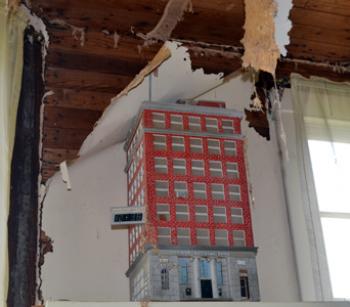
A model of Crowley's First National Bank building sits on a hearth underneath a collapsing ceiling int he building which used to house the Rice Museum.
Museum artifacts 'need a home'
Howell "Howie" Dennis is the news editor for The Crowley Post-Signal. He can be reached at howie.dennis@crowleytoday.com or 337-783-3450.
The Crowley Rice Museum hasn’t welcomed any visitors since 2005.
The building that housed the museum still stands on U.S. Highway 90 and has aged much the same way any home that was built over a century ago would; its ceilings are beginning to collapse and the wood has aged considerably.
What has Crowley Tourism Director Charlotte Jeffers concerned are the dozens of artifacts that once drew tourists from as far as Japan still housed inside the building.
“We have so many things in here that I wish I could show people when they come to Crowley,” she said. “This is a part of our history.”
Among the items that sit inside the building are dozens of pieces of antique farming equipment, neatly-constructed models of structures such as farms, rice mills and local buildings and other items that may not have much to do with the rice industry but are unique to Acadia Parish.
Examples of this are Nelson Stokely’s LSU helmet from the mid-1960s and a set of teeth belonging to a prehistoric creature which, were found in Acadia Parish.
Jeffers said her hope is that somebody will relocate the site of the museum so that the items can be displayed. She acknowledges that this would be expensive, however, and said that just having a place to store the items would be sufficient for now.
“It would be wonderful if one of the clubs or civic groups around Crowley would make a project out of this,” she said.
Diane Wright, a descendant of the famed rice pioneer S.L. Wright, is a former president of the museum’s board of directors and a descendant of the famed rice pioneer S.L. Wright. She said that the work, which was done on a strictly volunteer basis, began to overload the few who participated.
“We had a steady flow of people coming in but it got to be a bit much after a while,” she said. “A lot of my family’s stuff is in there.”
The museum was opened in 1968 under the leadership of Board President Phillip Caffery. Over the years, tourists from as far away as Japan and Belgium have passed through its halls. The guest book, which Jeffers still keeps in her office, includes the names of visiting politicians and pageant queens who wished to view items from Acadia Parish’s rich agricultural past.
“Morgan City has the Oil Museum, Lake Charles has the Mardi Gras Museum, we need to reopen the Rice Museum,” said Jeffers.
- Log in to post comments
